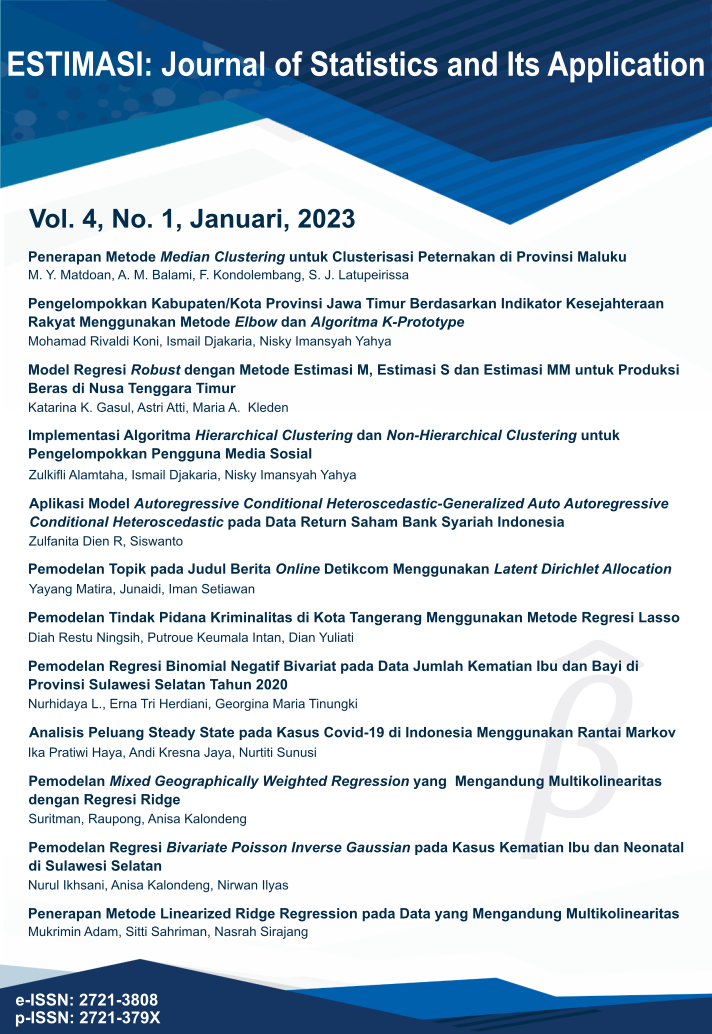Implementasi Algoritma Hierarchical Clustering dan Non-Hierarchical Clustering untuk Pengelompokkan Pengguna Media Sosial
DOI:
https://doi.org/10.20956/ejsa.vi.24830Keywords:
Davies-Bouldin Index, Hierarchical Clustering, Non-Hierarchical Clustering, Silhoutte Index, Social MediaAbstract
Social media is a means to interact with other people through sentences, pictures and videos online. Excessive use of social media has a negative impact on mental health. The grouping process in this study was carried out to see the level of social media use in Bone Bolango Regency. Before grouping, data pre-processing is carried out and the optimal number of clusters is determined using the Silhoutte index. The optimal cluster results obtained are two clusters for all methods. After that, grouping is done using Hierarchical Clustering and Non-Hierarchical Clustering Algorithms. The Hierarchical Clustering algorithm consists of two methods, namely the single linkage method and the complete linkage method. The Non-Hierarchical Clustering Algorithm consists of two methods, namely the K-Means and K-Medoids methods. The next step is to determine the best method using the Davies-Bouldin Index (DBI). The smaller the DBI value, the better the method used. The smallest DBI value is obtained in the complete linkage method. The grouping results for cluster 1 consisted of 70 respondents and cluster 2 consisted of 80 respondents.
References
Wiranda, N., Purba, H. S., dan Sukmawati, R. A. Survei penggunaan tensorflow pada machine learning untuk identifikasi ikan kawasan lahan basah. Indonesian Journal of Electronics and Instrumentation Systems, 10:179. doi:10.22146/ijeis.58315. 10 2020.
Roihan, A., Sunarya, P. A., dan Rafika, A. S. Pemanfaatan machine learning dalam berbagai bidang: Review paper. Indonesian Journal on Computer and Information Technology, 5:75–82. 2019.
Widyadhana, D., Hastuti, R. B., Kharisudin, I., dan Fauzi, F. Perbandingan analisis klaster k-means dan average linkage untuk pengklasteran kemiskinan di provinsi jawa tengah. Prosiding Seminar Nasional Matematika, 4:584–594. 2021.
Rahmawati, H. N., Iqom, M. K. B., dan Hermanto. Hubungan durasi penggunaan media sosial dengan motivasi belajar remaja. Jurnal Keperawatan Jiwa, 5:77–81. 2017.
Sosiady, M., Djamil, N., dan Ermansyah, E. The effects of internet addiction disorder on students’ learning motivation. Al-Ishlah: Jurnal Pendidikan, 14:3449–3460. doi:10.35445/alishlah.v14i3.1712. 7 2022.
Saifullah, Zarlis, M., dan Sembiring, R. W. Analisa terhadap perbandingan algoritma decision tree dengan algoritma random tree untuk pre-processing data. Jurnal Sains Komputer dan Informatika (J-SAKTI). 2017.
Aziz, A. R., Warsito, B., dan Prahutama, A. Pengaruh transformasi data pada metode learning vector quantization terhadap akurasi klasifikasi diagnosis penyakit jantung. 10. 2021.
N. N. Halim dan E. Widodo. Clustering dampak gempa bumi di Indonesia menggunakan kohonen self organizing maps. Seminar Nasional Integrasi Matematika dan Nilai-nilai Islami, 1:14-16. 2017.
Khoirunnisa, H., Ruchjana, B. N., Irianingsih, I., dan Suhandi, B. Perbandingan penerapan metode agglomerative dengan metode kmeans pada data curah hujan di wilayah bogor. 2020.
C. Suhaeni, A. Kurnia, dan R. Ristiyanti. Perbandingan hasil pengelompokkan menggunakan analisis cluster berhirarki, kmeans cluster, dan cluster ensemble (studi kasus data indikator pelayanan kesehatan ibu hamil), Jurnal Media Infotama. 14:1. 2018.
Supriyadi, A., Triayudi, A., dan Sholihati, I. D. Perbandingan algoritma k-means dengan k-medoids pada pengelompokan armada kendaraan truk berdasarkan produktivitas. 6:229–240. 2021.
B. J. D. Sitompul, O. S. Sitompul, dan P. Sihombing. Enhancement clustering evaluation result of davies-bouldin index with determining initial centroid of k-means algorithm. Journal of Physics. 1235:1. 2019.
Downloads
Published
Issue
Section
License
Copyright
It is the author's responsibility to ensure that his or her submitted work does not infringe any existing copyright. Authors should obtain permission to reproduce or adapt copyrighted material and provide evidence of approval upon submitting the final version of a manuscript.


